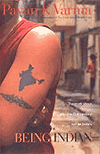| |
BOOK
REVIEW
The
inscrutable Indians
Being Indian by Pavan K Varma
Reviewed by Chanakya Sen
The greatest asset of any country is its
people. This aphorism holds especially for
India, whose pool of human resources and
talent makes the best in the world envious.
Diplomat Pavan  Varma's
new rendering is a discourse on what it means
to be Indian in the 21st century, and what
characteristics make Indians tick with
resilience and elan in varied fields of
excellence. Varma's
new rendering is a discourse on what it means
to be Indian in the 21st century, and what
characteristics make Indians tick with
resilience and elan in varied fields of
excellence.
Generalizations on national psyche are
amenable to be challenged via exceptions or
counter-examples. Ergo, Varma disclaims in the
preface: "India is too big and too
diverse to allow for convenient cover-all
labels." Yet personality traits and
behavioral patterns that are distinctly Indian
do exist, accumulated over centuries of
conditioning. Varma's quest is to dig into the
core of this Indian-ness using history as the
teacher.
The stereotypes in which foreigners see
Indians and the self-image that Indians
project about themselves are both inaccurate.
Indians are considered democratic, spiritual,
tolerant, peaceful etc. But Varma's
value-neutral reappraisal throws up surprising
conclusions that can be embarrassing. Indians
respect the powerful and will collude with
them for personal gain. They are extremely
hierarchical, bending before superiors and
subjugating inferiors. They have never been
"other-worldly" and hanker for
material prosperity. Spiritualism is
"mostly a means to harness divine support
for power and pelf". (p 7) Morality is a
theoretical construct abjured as impractical
in real life. Indians also sanction violence
when convinced of numerical strength and
surety of victory. Varma's thesis is that some
uncomplimentary facets of Indians are actually
assets that make them resilient, tough and
successful.
The kowtowers
Indians are congenitally sensitive to the
power calculus. From the Maharajas and the
British to modern politicians, the powerful
are not expected to be reticent or modest in
the Indian tradition. Power is a legitimate
pursuit and the winners are expected to flaunt
it. Caste rigidities may be blurring today but
the preoccupation with everyone's place in a
hierarchy persists, akin to Confucian value
systems. Indians are obsessed with status.
They discount the morality and means of
securing status as long as one becomes mighty.
Hinduism's flexibility "always allowed a
conveniently fractured response to the moral
imperative". (p 29) Beliefs never come in
the way of personal gain.
Pragmatic Indians have always collaborated
with a stronger power, especially foreign
conquerors (poignantly essayed in Amitav
Ghosh's novel The Glass Palace). They
are willing to acquiesce in the abuse of power
when it seems undefeatable. If power is
ascendant, Indians opportunistically defer.
When it is declining, they turn hostile.
Personal rivalries, factions, jealousies and
intrigue are stock-in-trade of the Indian
mind. Yet Indians collude without being
subsumed by masters, a detachment which has
preserved the Hindu way of life despite being
overrun by Muslim and Christian invaders.
Absence of ideals in the functioning of Indian
democracy is the result of a "societal
consensus" where power is the end and all
the rest are instrumentalities in reaching
that end. Indira Gandhi was the leader Indians
trusted the most as she played the power game
with dexterity and ruthlessness. Democracy
survives in India as the most effective
instrument for the pursuit of power and upward
mobility. It "provides legitimacy to
hierarchies". (p 54) Indians have a
special genius for political accommodation and
compromise since the pursuit of power would
close if the institution of democracy
collapsed.
The materialists
A universal Indian feature is "to
single-mindedly pursue material benefit in the
most adverse and improbable situations".
(p 61) The most important deities in the Hindu
pantheon are Lakshmi (goddess of wealth) and
Ganesh (remover of obstacles to commerce). Artha,
procurement of wealth, is among the four
fundamental goals of Hindu life. Only a person
with material means could properly tread the
path to moksha (salvation). Hindus show
little compassion for the indigent and the
downtrodden. The Ramayana epic says,
"There is no difference between a poor
man and a dead one."
Entrepreneurship is in Indian blood. In a
scarcity economy, only the fittest are able to
survive. With instincts for improvisation,
initiative, quick thinking and cunning,
Indians are "street-smart about making
money". (p 74) Most Indians privately
agree that money may not be god, but no less
than god. Nothing distracts them from the
opportunity to make a fast buck. Indians are
willing to live easily with an "ethical
deficit" (former prime minister Atal
Bihari Vajpayee), a dual chalice containing
corruption as well as robust commercial
acumen. The ideologies of socialism or
Gandhian austerity are "clearly not in
sync with the Indian psyche". (p 86) The
protuberance of consumerism since 1991 is
entirely in keeping with Indian inclinations.
Economic reforms unleashed India's mammoth
entrepreneurial energy and adaptability but
also deepened its neglect of the poor.
Metaphysical concepts like maya
(illusion that the world is real) are
lip-serviced when the going is good, but
dusted out in times of adversity to "give
failure the cushioning of philosophical
acceptance". (p 99) Indians are better
able to survive distress and mishaps owing to
certain unique concepts in their religious
beliefs.
The technocrats
What is the role of culture in nurturing
Indians as the czars of the information
technology revolution? Mathematics is the
single greatest contribution of India to the
world of science. In Vedic times, Indians
mastered numeration as part of religious
ritual. More than 3,000 years ago, Indians
built the world's most extensive database, the
Bhrigu Samhita, predating modern information
management. A bias in favor of competence in
math goes back to millennia. Indians have an
innate receptivity to the interconnectedness
of things. They are able to structure a link
between a sum and its parts, and see patterns
of networks invisible to most others. "A
German or a Japanese will work meticulously
within the system. An Indian is taught to take
failure of the system in his stride and find a
solution anyhow." (p 145)
Indian culture forever looks down on manual
labor as degrading and higher studies as the
ladder to climb the hierarchical totem pole.
Hence, institutes of higher learning and
technical education proliferated after
independence at the cost of primary education.
The largest number of unschooled children and
the largest reservoir of trained geeks coexist
in India. Social callousness for the uplift of
the marginalized has ironically made India an
IT superpower.
Relentless greed for money has motivated
Indian IT entrepreneurs, who head the list of
the country's billionaires. The salary of an
IT professional is much higher than the amount
spent to acquire his or her skills. Working
knowledge of English, a major asset of Indians
in the IT market, is a product of the Indian
eagerness for Lord Macaulay's project of
creating "a class of persons, Indian in
blood and color, but English in taste,
opinions, morals and intellect". English
is an instrument of social exclusion in India,
but paradoxically for the IT industry, "a
bane has become a boon". (p 127)
Many Indian techies are at the low end of the
value chain, mocked as "cyber
coolies". Varma links it to
"centuries of hierarchic regimentation
that conditioned them to obey rather than to
innovate … to embellish the groove rather
than to explore new avenues." (p 130) All
Indians harbor a deep inferiority complex
toward the West and are stuck in a "vast
imitativeness trying to be like someone
else". (p 134) The flag bearers of the
new economy are ironically socially backward
and trapped in old conservatism. Many have no
objections to extorting fat dowries and
humiliating women.
The unifiers
India's perceived diversity is often
deceptive. Indians have a vast number of genes
in common. Their polyglot vocabulary has its
roots in only four major language families.
Varma sees "a new supranational Indian
culture that cuts across class barriers and
permeates all aspects of daily life: dress,
food, art, language, employment and
entertainment". (p 149) Indians are far
more homogenized than they can admit. The
salad bowl is emptying into a melting pot,
dissolving differences.
Radio, television, Bollywood, cricket, popular
music etc are mediums fast integrating India's
1 billion plus denizens. So many more Indians
speak Hindi today that it would surprise the
language's staunchest opponents. The
anti-Hindi bastion of Chennai has more private
tuitions for learning Hindi than any other
city. Markets have homogenized a pan-Indian
class of consumers. There is an identifiable
similarity across the country in product
tastes and preferences. Increasing middle
class domestic tourism means Indians are no
longer strangers in their own land.
Though violence is a staple in society,
Indians have displayed unwarranted pacifism in
dealing with external threats. In the 1999
Kargil war, the option of destroying staging
posts and supply lines of invaders across the
border was rejected. After the Pakistan
retreat began, Indian forces were ordered not
to shoot in the back. During the 1999 IC-814
plane hijacking, the overriding concern of the
state and relatives of victims was the lives
of hostages, not the national interest of
confronting terror. In dealing with internal
threats, Indians do not think that to concede
is to lose. Concessions co-opt extremists and
sanctify the mainstream. Historically, all
separatist movements have been eventually
contained, assimilated and diluted by this
ploy.
Varma opines that the vision of India engulfed
in perpetual religious strife is vastly
exaggerated (see Khushwant Singh's The End
of India). Remarkably self-assured Hindus
have never been insecure about their religion.
They accepted Muslim and Christian rulers but
not their faith. No practical alternative to
religious coexistence is comprehensible to the
average Indian. For workers as well as
businesspersons, there is no choice but
communal harmony. In politics, Muslims form
political alliances with Hindu parties.
Condemnable riots are actually outnumbered by
"countless incidents of religious harmony
in the daily ebb and flow of life". (p
181) Indians are hard-nosed realists wanting
to get on with their daily work rather than be
mired in self-defeating identity quagmires.
Varma concludes with the thesis that public
policy in India has mostly been insertion of
square pegs in round holes. It should be
congruent with the behavioral patterns of
Indians as they are, not as they ought to be.
India will not fall apart, but for it to
attain critical mass for take-off as a major
world power, Indian policymakers should know
the nature and proclivities of their people
and design policy interventions buttressing
them.
This book is controversial for its candid
debunking of myths about Indians.
Psychoanalysis has been brilliantly used to
bare the average Indian sans affectations.
Those who felt understanding inscrutable
polymorphic Indians was impossible now have a
master guide.
Being Indian by Pavan K Varma, Penguin
Books India, New Delhi, 2004. ISBN:
0-67-005780-0. Price: US$ 7.50, 238 pages.
(Copyright 2004 Asia Times Online Ltd. All
rights reserved. Please contact [email protected]
for information on our sales and syndication
policies.) |
|
|
 |
|




 Varma's
new rendering is a discourse on what it means
to be Indian in the 21st century, and what
characteristics make Indians tick with
resilience and elan in varied fields of
excellence.
Varma's
new rendering is a discourse on what it means
to be Indian in the 21st century, and what
characteristics make Indians tick with
resilience and elan in varied fields of
excellence.
